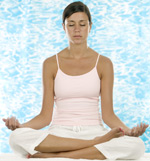“If you can’t put it on your tongue, don’t put it on your skin.” – Bhaswati Bhattacharya, MPH, MD
Overview
 The treatment protocols of Ayurveda are focused on a person’s individual mind-body constitution, or prakriti, which in turn is based on the amounts of three different characteristics called doshas. The doshas essentially represent the personality and physiological traits that a person is born with. The three types include Vata (air, ether), Pitta (fire, water) and Kapha (earth, water). These types are generally present in varying amount in an individual with two dominating (i.e. Vata-Pitta, Vata-Kapha, or Pitta-Kapha). Assess your dosha’s with the dosha quiz from the Chopra Center.
The treatment protocols of Ayurveda are focused on a person’s individual mind-body constitution, or prakriti, which in turn is based on the amounts of three different characteristics called doshas. The doshas essentially represent the personality and physiological traits that a person is born with. The three types include Vata (air, ether), Pitta (fire, water) and Kapha (earth, water). These types are generally present in varying amount in an individual with two dominating (i.e. Vata-Pitta, Vata-Kapha, or Pitta-Kapha). Assess your dosha’s with the dosha quiz from the Chopra Center.
Ayurvedic treatments are often undertaken to re-align the doshas, as they can be easily influenced by food, temperature, season, stress, etc.. Ultimately, Ayurveda sees disease as a matter of imbalance. Its treatments and recommendations are totally individualized to a person’s condition and constitution at one particular point in time.
Find an Ayurveda Practitioner here (NAMA certified).
Exercise in Ayurveda
As a means of creating balance and optimal health, Ayurveda recommends daily exercise of mind and body. The primary form of exercise utilized is yoga, which means “to yoke” or “union” as it is said to bring together the mind with the body. A general yoga practice of honoring the sun called the surya namaskar (sun salutation) is often performed at sunrise and sunset. This sequence includes twelve different poses combined with deep breathing (pranayama) in a form of moving meditation. Watch this video from Yoga Journal for a simple sun salutation For more info, see the Yoga page.
Detoxification (Panchakarma)
The practice of Panchakarma is an important daily ritual in Ayurveda. The term Panchakarma means “five cleansing therapies.” Its focus is to help the body to purify itself by removing toxins. Manipulation of the marma points (which are similar to acupuncture points) is one of the panchakarma techniques which is said to help balance the body, mind and spirit.
A variety of hygiene practices can be incorporated into a daily routine to both prevent the build-up of toxins and to encourage their elimination. Some simple suggestions as discussed by Bhaswati Bhattacharya, MPH, MD during a lecture at The Graduate Institute, include:
- A daily practice of washing the face with cool water, then cleaning the inside of the mouth being sure to scrape the tongue with a copper scraper, brushing the teeth with SLS and fluoride-free toothpaste, and performing oil pulling (gandosha – swishing sesame oil in the mouth for 10 minutes).
- Drinking warm water to encourage daily elimination.
- Having regular massage with Ayurvedic oils.
- Using the philosophy, “if you can’t put it on your tongue, don’t put it on your skin.”
Sample Ayurveda Prevention / Detoxification Plans
Editor’s Note: I have been able to easily incorporate Ayurvedic practice into my daily routine by adding cilantro to my meals, and using a dry brush for skin brushing before I shower. I also apply Ayurvedic massage oil before bed and before yoga, and I burn sandalwood incense for relaxation. I use an all-natural, kohl eye liner, along with variety of other Ayurvedic beauty products such as fluoride-free fennel toothpaste and sandalwood soap. And, when my mouth is feeling dry I swish with sesame oil. Finally, I approach my daily yoga practice with a new appreciation for incorporating chanting, prayer and reverence.
- A Detoxification Practice from the Chopra Center
- Ayurvedic Herbs from the Chopra Center
- A Sample Daily Routine by Vasant Lad, MASc
- Ayurvedic Approaches for Weight Loss
- The Benefits of Ayurveda Self-Massage
Ayurveda Nutrition
The Ayurvedic focus of nutrition is very different from Western medicine. The approach follows these holistic principles:
- Herbal medicines are used to strengthen the body vs. treating health problems after they arise.
- All of an herb (herbal formulas) is used vs. extracting just the “active” ingredient as is done in Western medicine.
- Meals are balanced according to six tastes (sweet, salty, sour, bitter, pungent, and astringent) rather than nutrient content. The doshas can be adjusted based on the tastes of foods that are consumed.
- Savoring meals is encouraged with just one dish eaten at a time. If you enjoy a food you can serve yourself more, but you don’t move on to another dish until you are ready to eat only that item.
Nutrition Resources
- An explanation of the Six Tastes from Kitchen Doctor including the following chart:
|
Elements and Tastes |
|
|
Air |
astringent, bitter |
|
Fire |
pungent, sour, salty |
|
Water |
sweet, salty, sour |
|
Earth |
sweet, astringent |
- The Six Tastes in relation to the doshas http://www.eattasteheal.com/ETH_6tastes.htm
- World’s Healthiest Foods – The Ayurvedic Diet
[Last Updated: 5/12/15]
